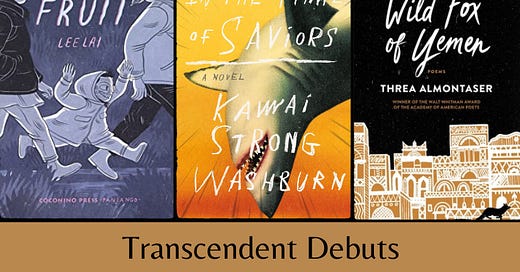Volume 1, No. 7: Transcendent Debuts + Maple Oatmeal Scones
Greetings, readers and eaters. A few weeks back I mentioned I saw a northern flicker for the first time. Today I watched one out the window while I wrote most of this newsletter. I’ve also learned what their calls sound like so now I hear them constantly. It’s such a joy when small things about the world around me come into focus like this.
In other news, I recently bought myself some tulips, and they delight me whenever I look at them.
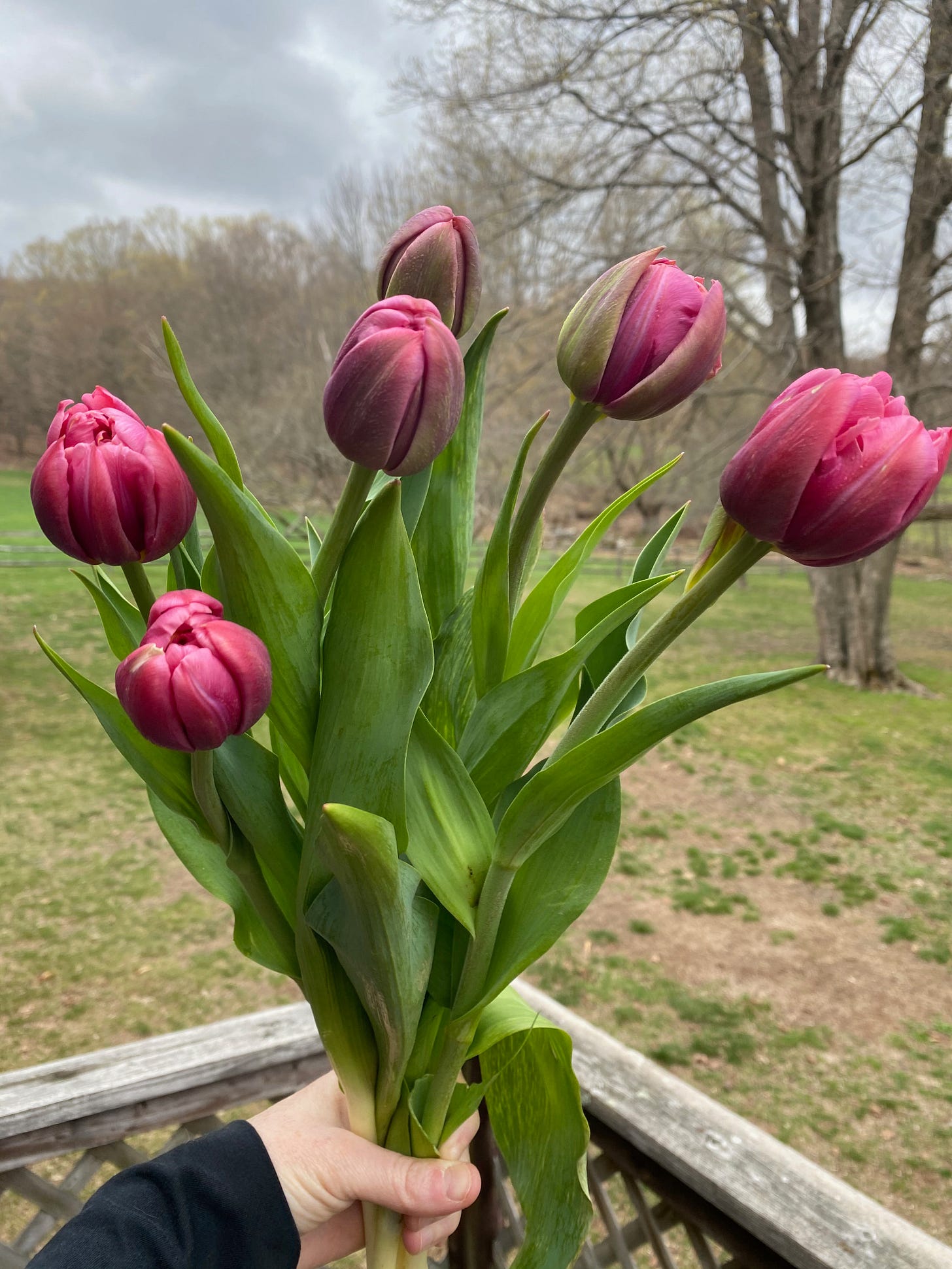
Last week it was all about second books. This week it’s all about debuts. A ton of amazing debuts come out every year. But it’s not every day that I read an author’s first book and immediately vow to read everything they ever write. That’s how I feel about these three authors. I know how much work goes into making a book, so I’m not going to mope around impatiently. But I will click that preorder button as fast as humanly possible the moment I learn one of these amazing writers is publishing something new. I’m getting excited just thinking about it.
The Books

Backlist: Sharks in the Time of Saviors by Kawai Strong Washburn (Fiction, 2020)
If we hang out in real life, or if we know each other via the bookish internet, you may have already heard me talking about how much I love this book. I feel like an overexcited little kid right now, tumbling over my words in my eagerness to explain how deeply this novel moved me. I badly want to shove it into everyone’s hands and say: “Look! This! This book is why I read!”
This book is why I read. It’s the kind of book that reminds me what fiction can do, how it can crack the world wide open. It’s a book so alive, so expansive, so full of stories—stories upon stories upon stories—that I can still feel the unshakable truth of it in my bones. Every so often, in the pages of a novel, an author captures what it actually feels like to be a human in the world. Every so often, a book becomes a doorway—not because of where it takes you, but because it could take you anywhere. This book did that for me.
It’s a breathtaking family epic, a multi-voiced saga about a Hawaiian family struggling to survive after the collapse of the sugarcane industry. It’s about familial expectation, messy sibling relationships, the stories that live inside bodies. It’s about lineage and legend, poverty and addiction and first love, belonging, the pull and power of landscape. There is a wisp of magic running through it, but it’s not a magical book. Like everything else in this novel—the characters, the writing, the setting—the magic is deeply layered. Sometimes it fades into the background and sometimes it becomes central.
The book opens in 1995 in Kailua-Kona, Hawaii. On a family vacation, seven-year-old Nainoa falls off a boat into the ocean. He’s rescued by sharks, and afterward develops strange healing powers. Over the next fifteen years, this event becomes the family’s defining story, reverberating through their lives in continually surprising ways. The story unfolds through four POVs: Nainoa, working as a paramedic in Portland; his younger sister Kaui, at college in California; his older brother Dean, living in Spokane, Washington; and his mother Malia, in Hawaii.
I’d like to write several paragraphs about each of these characters, because they are what make this book so extraordinary. It’s not just that I loved them, or that I was so invested in their lives I often found it hard to breathe while reading. It’s that every POV is so distinctly compelling. Sometimes, in a multi-POV novel, I’ll find myself drawn more toward one character or another. In this book, I wanted to spend as much time as possible with every single character. I could have read a whole novel about each of them. I’ve rarely encountered characters with so much emotional depth, characters so messy and real I’m honestly pretty sure they’re actually out there somewhere, living their lives.
Part of what makes the characters so vivid is Washburn’s prose. There are four first-person POVs in this book, and they sound nothing alike. The writing itself—its rhythm, syntax, music, and grammar—changes as Washburn moves between POVs. It gives the book an incredible intimacy and a startling momentum. Nainoa, Dean, Kaui, and Malia see and experience the world in different ways. They have different fears, desires, coping mechanisms, weird quirks. Different things they love, that make them laugh. All of that comes through in the words they use to tell their stories. We get to experience how they see each other, and also how they see themselves. It’s masterful.
I’ll leave you with this beautiful passage from one of Malia’s sections. She captures the heart of what this book is about better than I ever could:
If a god is a thing that has absolute power over us, then in this world there are many. There are gods that we choose and gods that we can’t avoid; there are gods that we pray to and gods that prey on us; there are dreams that become gods and pasts that become gods and nightmares that do, as well.
Finally: I listened to this on audio, and I don’t have the words for its brilliance. It’s read by four narrators: Jolene Kim, Kaleo Griffith, G. K. Bowen, and Tui Asau. They are magnificent. If you listen to books, listen to this one. It’s a masterpiece.
Frontlist: The Wild Fox of Yemen by Threa Almontaser (Poetry)
I find it difficult to review poetry. I think this is partly because of the way I read it. A while back, I stopped trying to analyze it. Now I just let the words sink into me. For me, poetry is a fleeting experience. I love a poem if it makes me feel something deeply in the moment that I read it: anger, despair, joy, longing, heartbreak, delight. But I don’t hold onto poems anymore. I return to the ones I love, but I've stopped trying to capture them. There’s a wonderful freedom in this, and I read way more poetry now than I used to. But it does make it hard to write about, sometimes. I will do my best here. What it boils down to is: if you like contemporary poetry, read this book.
Almontaser is a Yemini American writer from New York. One of the things I love most about this collection is how deeply steeped it is in the places that matter to her. I know very little about Yemen, but it comes alive in her words. She writes about both Yemen and New York with love and longing, terror and heartbreak, exhaustion and pride. These poems are about homeland, belonging, history, exile. None of it is simple. There’s a specificity to the stories she weaves: the poems are full of specific streets, foods, buildings, rituals. But she also captures the essence of betweenness: what it’s like to exist between times, places, cultures, people, languages, versions of self.
It’s this beautiful blending of rootedness and looseness that took my breath away again and again. In “Ode to Bodega Cats” she writes:
All I want is to be an adequate ancestor
to the Yemini women who come after. Who visit
my grave with bundles of nut meat for their great-
auntie with the immortal hips, that, myth says, broke
high facility fences and let out all the paperless.
I can’t get over this image, the way it ties the speaker of this poem to the past and the future. These lines contain so many stories, so many lives lived, real and imagined. The whole collection is like this, leaping through time and space, firmly rooted in the real one moment, delving into dreams the next. It’s playful, expansive, inventive.
Everywhere, her language is delightful, as in these gorgeous stanzas from “Yemen Rising as Poorest Country in the World”:
This country a trading port, a locust flying full speed,
a jinn queen, a pleasant resonant, a goggle of glimmering
noses. This country who invites a whole village
over for tea is a blue diwan, a spice road, an Arabia Felix.
She’s constantly transforming language, playing with what it means to translate, to speak. Many poems are about language itself, especially the pain of losing native and ancestral languages. The grief in these poems is palpable. I felt so many of these lines about language in my body:
Where did my old words go, my first words? I found my native speech like a trap
door, the Arabic softening my fall. Now the words shed
from my mouth like deciduous teeth.
Neither muscle nor mouth
devoted to one way of speaking. Every language
I borrow from somewhere else.
Breaking news: we are all transplants in the wrong body. Too soon, I am smoke swallowed by the sky, nowhere.
Throughout, she weaves Arabic words into the text, sometimes written in English characters and sometimes in Arabic ones. She also includes several of her own translations of poems by Yemini poet Abdullah Al-Baradouni. This blending of language gives the whole collection so much texture. She’s trying to figure out what language can do, and also what its limits are. She’s interested in how language connects and severs, how it can act as both bridge and wall.
In the poem “Heritage Emissary” she writes: “I can’t properly translate myself” and follows it with two stanzas written from right to left, rather than left to right. It’s such a powerful moment of invitation for the reader: an invitation to attempt a translation, and then to sit in that uncomfortable place where words don't alway match, where words aren’t always enough.
Every poem in this collection feels like some kind of invitation: into the mysteries of words, into wonder, into a thousand variations on home, into the depths of language.
Upcoming: Stone Fruit by Lee Lai (Graphic fiction, Fantagraphics, 5/11)
This graphic novel is stunning in every way: visually, thematically, emotionally. It’s a quiet story about parenthood, aunthood, and sisterhood. It’s about found family and family of origin, partnership, wildness, mental health, forgiveness.
Bron and Ray are a queer couple in their twenties, aunties to six-year-old Nessie. They spend time with Nessie every week, helping her single mom, Ray’s sister Amanda, with childcare. When the three of them are together, Ray, Bron, and Nessie create a magical world full of adventure and joy. It’s a sacred space away from the demands and constraints of the outside world. But as tensions in Ray and Bron’s relationship escalate, their time with Nessie starts to lose some of its magic. Bron leaves to visit her family for the first time in years. Ray starts spending more time with Amanda.
That’s it. That’s most of the plot. It sounds simple; it isn’t. It’s a book about people trying to figure out how to be in relationship with each other—as sisters, as aunties, as partners. It’s full of scenes that reflect the cadences of daily life: making dinner, washing dishes, doing errands. In both the art and the writing, Lai captures the spaces where so much of life happens. Ray in bed, unable to sleep after Bron leaves. Ray and Amanda drinking tea in Amanda’s kitchen. Bron gardening with her mother. All of these ordinary things are happening while the characters are in turmoil. That’s what makes this such an emotional read. It feels exactly like real life, which doesn’t stop, even when things are hard and bad and exhausting.
I love stories about found family, but I also love books about the blurry lines between found family and family of origin. This is a book about all the messy shapes that family can take. The time that Ray, Bron, and Nessie spend together feels distinctly queer. I don’t know how else to describe it; it feels like the essence of queer family. There’s an entirely different kind of belonging that emerges between Ray and Amanda when they start spending more time alone together. Bron has a complicated relationship with her family, who weren’t accepting of her queer and trans identity in the past. But she finds common ground with her teenage sister when she goes to stay with them. In many ways, it’s painful for her to be there. But spending time with her sister is healing for her in a way that spending time with Nessie isn’t.
Lai captures all these webs of connection so beautifully. She doesn’t rank them against each other. She simply lets her characters exist inside them. Everyone is messy. Everyone is engaging with people who’ve hurt them. That’s what makes the story feel so alive. It’s a book full of mistakes and second chances and relationships that are constantly changing.
Like Ray and Bron, I am an aunt, and I don’t have kids of my own. This book resonated so deeply with my own experience of aunthood. Part of this has to do with the art, which is breathtaking. When they’re together, Bron, Ray, and Nessie all transform, visually. Lai draws them as creatures with big teeth and bright eyes, their bodies turning into beautiful monsters. They become wild. It’s such a poignant way to express how it feels, as an adult, to spend time with beloved children. I don’t know what it’s like to be parent, but this raucous, delicious freedom is something I associate with being an aunt. There’s a particular way it feels, loving a child who is not yours. Lai drew that feeling. I couldn’t look away.
The intricacy and complexity of the art also makes the differences between the worlds the characters move through painfully stark: adulthood and childhood, aunthood and parenthood, magic and responsibility. The whole book is about flawed humans trying to figure out if it’s possible to live in many worlds at once.
I cannot wait to see what Lee Lai does next. In the meantime, this gem is out May 11, and you can preorder it here.
The Bake
I love all of Joanne Chang’s cookbooks, and I especially love her newest, Pastry Love. But I will always have a deep fondness for her debut, Flour. It’s full of beloved recipes, including this one. It’s where I learned to make brioche. It’s got an absurdly perfect recipe for hazelnut almond dacquoise (if you’re up for a challenge), and it’s also a fantastic book for beginning bakers. I recently gave it to my ten-year old nephew, who is not a beginner anymore, but who seems to be enjoying it (he recently made the sticky buns).
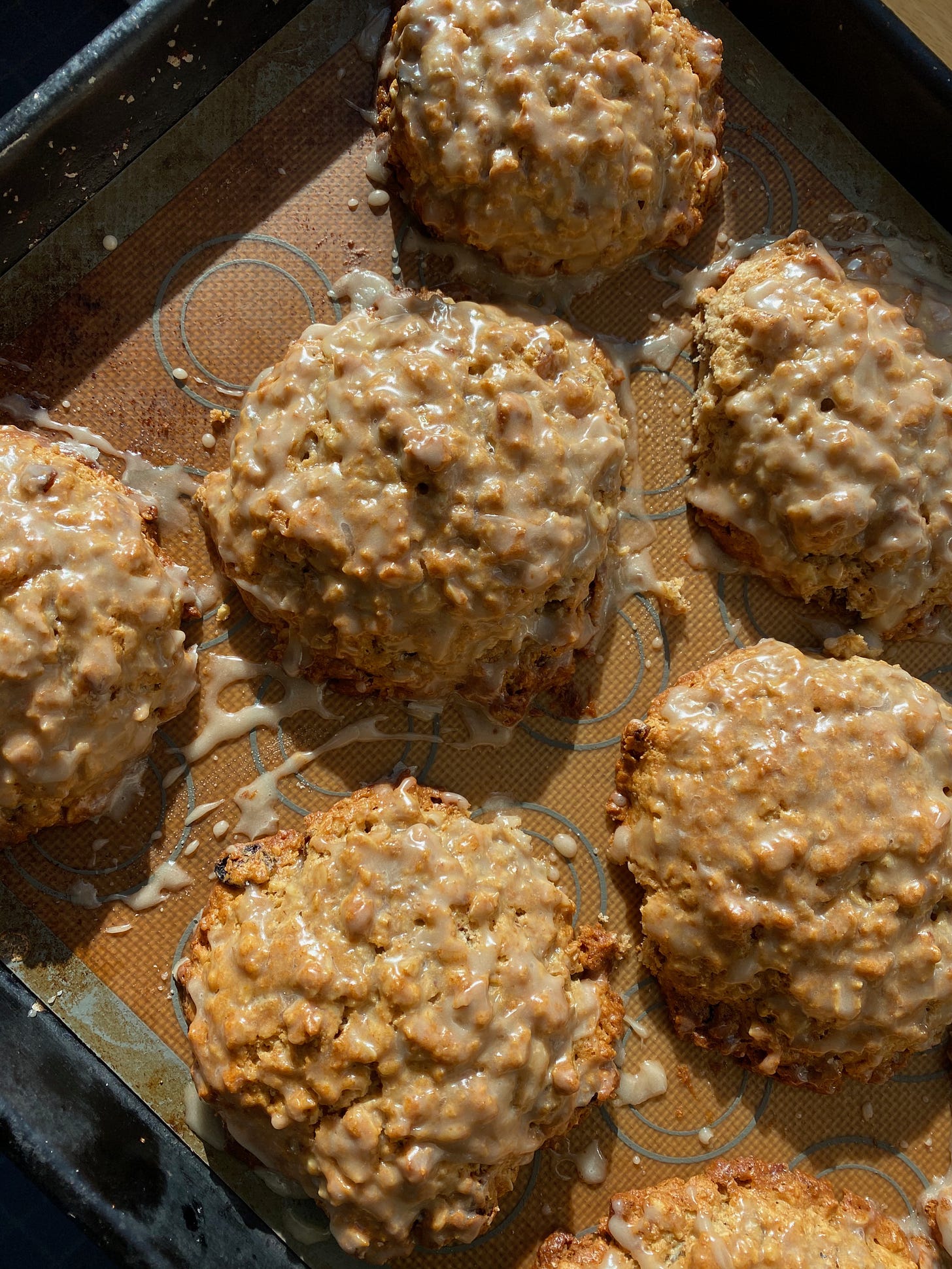
Maple Oatmeal Scones
Makes ~8 scones
These aren’t flaky, airy scones—they’re craggy and crumbly. And delicious. They only take a few minutes to whip up, they freeze beautifully, and you can adapt them to suit your taste. The original recipe calls for raisins, which I’ve left out. But you can add them back in, or use different nuts, or throw in some spices. Personally I love the intense maple flavor of these just the way they are.
Ingredients
210 grams (1 1/2 cups) all-purpose flour
125 grams (1 1/4 cups) rolled oats
1 1/2 tsp baking powder
1/4 tsp baking soda
1/4 tsp salt
50 grams (1/2 cup) pecans, toasted and chopped
8 Tbs (1 stick, 1/2 cup) cold unsalted butter, cut into 8-10 pieces
1/3 cup (80 grams) heavy cream
1/2 cup (160 grams) maple syrup
1 egg
Preheat the oven to 350. Line a baking sheet with parchment or a silicone baking mat.
In a stand mixer fitted with the paddle attachment (or in a bowl with a wooden spoon), mix together the flour, oats, baking powder, baking soda, salt, and pecans. Add the chopped cold butter and mix on medium low speed for about 30 seconds, until the butter breaks down into small clumps. (You can do this part with your fingers or a pastry cutter if you don’t have a stand mixer.)
In a small bowl, whisk together the cream, maple syrup, and egg. Pour this mixture into the flour mixture and beat for another 30ish seconds, until the dough comes together. It will be quite wet. Give it a few good scrapes with a rubber spatula to make sure everything is well combined. (You can do also do this with a wooden spoon or handheld beaters.)
Using a 1/3 cup measuring scoop, drop mounds of dough onto the prepared baking sheet. I usually get eight scones, but sometimes end up with six or nine. Space them 2-3 inches apart. You can freeze the unbaked scones, wrapped in plastic, and bake from frozen—just add 5-10 minutes to the baking time.
Bake for about 40 minutes, until golden brown on top.
Meanwhile, if you want, make a glaze: Combine 140 grams (1 cup) powdered sugar with 3 Tbs maple syrup. Keep adding syrup, a little bit at time, until you reach a smooth, pourable consistency. (You can also use a few tablespoons water or milk; I like a more intense maple flavor.)
Let the scones cool for a few minutes before glazing and eating.
The Bowl & The Beat
The Bowl: Red Curry Noodles with Whatever Veg You Have Lying Around
I picked up some bok choy and cilantro from a local farm last week (spring!), added some tofu and mushrooms that had been sitting in my fridge for a while, and called it a meal. I make some variation of this dish almost every week, because it’s so tasty and so adaptable. Full disclosure, though: the red curry paste I get from Little Trúc in Easthampton is out of this world delicious. Valley folks, we are so lucky.
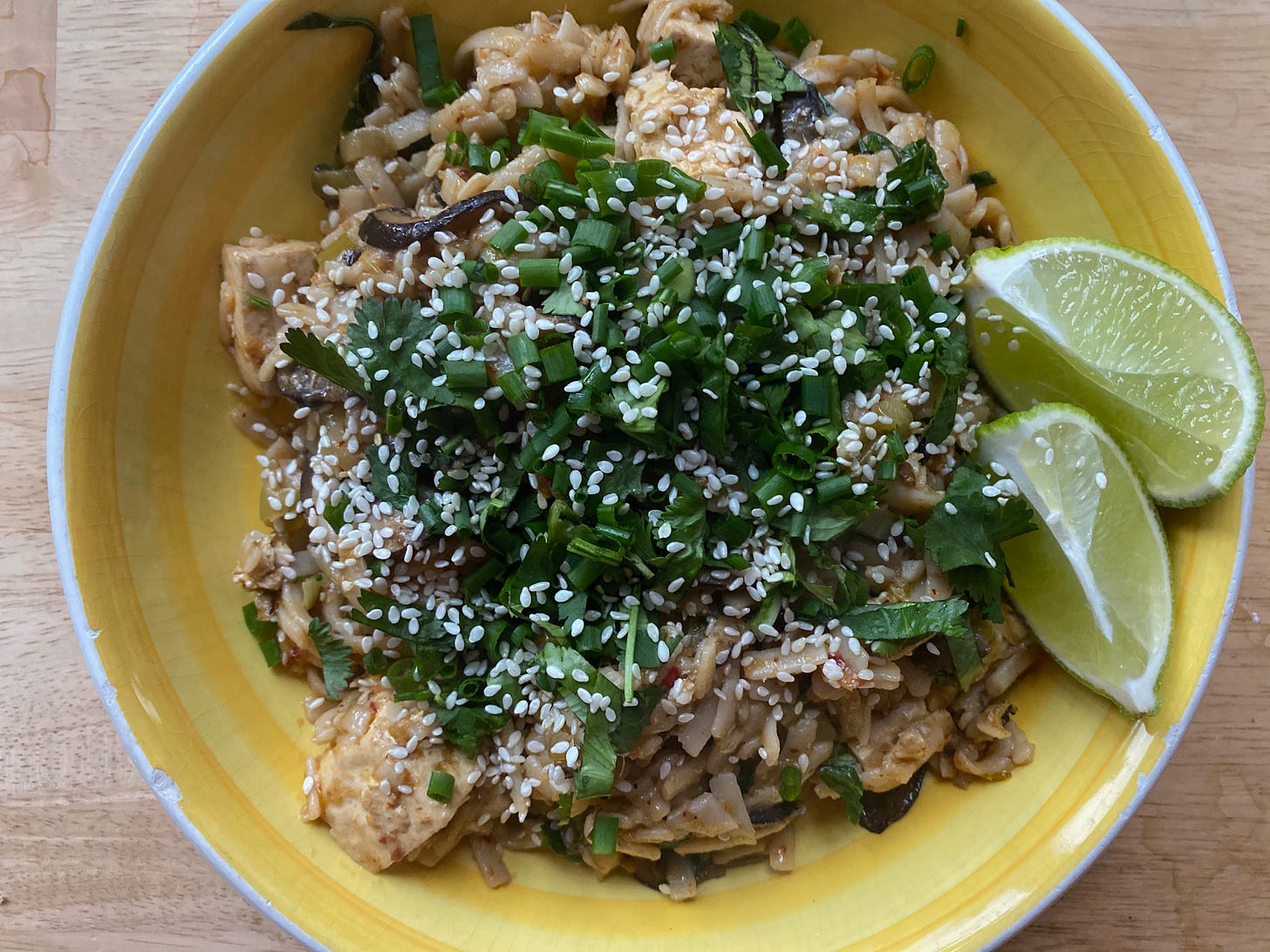
Heat some coconut oil in a large skillet. Add a minced onion or a few shallots, a few cloves of garlic (minced), a few scallions (sliced thinly), and a handful of sliced mushrooms—shiitakes if you have them, but any kind will work. Sauté until everything is soft and golden, ten minutes or so. While that’s happening, cook a package of rice noodles; drain and set aside. If you’re using tofu, cube it, add it, and sauté for another 10ish minutes. Then toss in red curry paste (1/4 cup or so), a can of coconut milk, a splash of fish sauce, and some lime juice. Stir it all up. Add whatever other vegetables you want: snow peas, bell peppers, and boy choy are all lovely. Cook a few more minutes, until the veggies are how you like them and the sauce is slightly thickened. Fold in the noodles. Serve topped with scallions, cilantro, sesame seeds, and lime wedges.
The Beat: Audiobooks That Have Made Me Laugh in 2021
I’m currently listening to a book I’m planning to feature here later, so instead of telling you about that one, I thought I’d share a few books I’ve listened to recently that have made me laugh out loud. These are all fun, mostly lighthearted reads—in case you need a little joy in your ears.
Get A Life, Chloe Brown by Talia Hibbert, read by Adjoa Andoh: This book is a gem. I laughed so hard, so many times. Andoh is brilliant. Hibbert is brilliant. I love every book in this series, but this one is my favorite. I’m smiling just thinking about it.
A Complicated Love Story Set in Space by Shaun David Hutchinson, read by Kevin R. Free, Gibson Frazier, and Candace Thaxton: Gays in space! Lots of adventure! Baking! Many surprises! Also, Kevin R. Free is one of my all-time favorite narrators and he is phenomenal here.
Stepping Stones by Lucy Knisley, read by a full cast: I love listening to graphic novels on audio, and this is such a fun one. It’s a middle grade story about a girl who’s just moved to a farm in the country with her mom, stepdad, and new stepsisters. It’s short, funny, and heartfelt, with great audio effects.
The Bookshelf
The Library Shelf
Friends, it is almost exactly the same as last week. I did manage to return Homesick by Nino Cipri and Love and Other Poems by Alex Dimitrov, both of which I enjoyed. But soon looming due dates are going to start catching up with me.
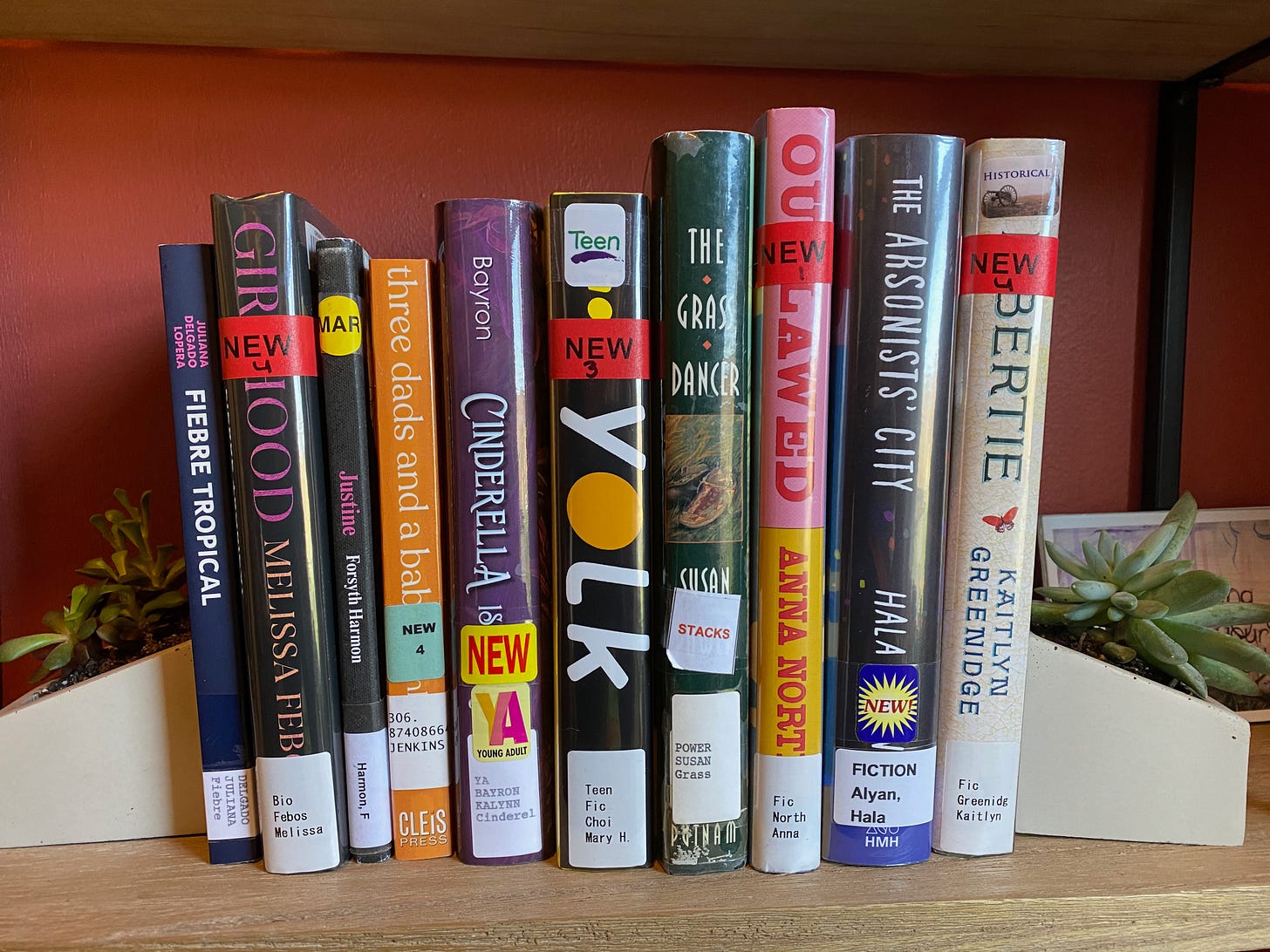
The Visual
I recently ordered a whole bunch of books from Metonymy Press, a tiny queer press in Montreal that I am obsessed with. They’ve published some of my favorite books of the last few years. I raved about Little Blue Encyclopedia (for Vivian) a few weeks back. I can’t wait to dive into the ones here I haven’t read!
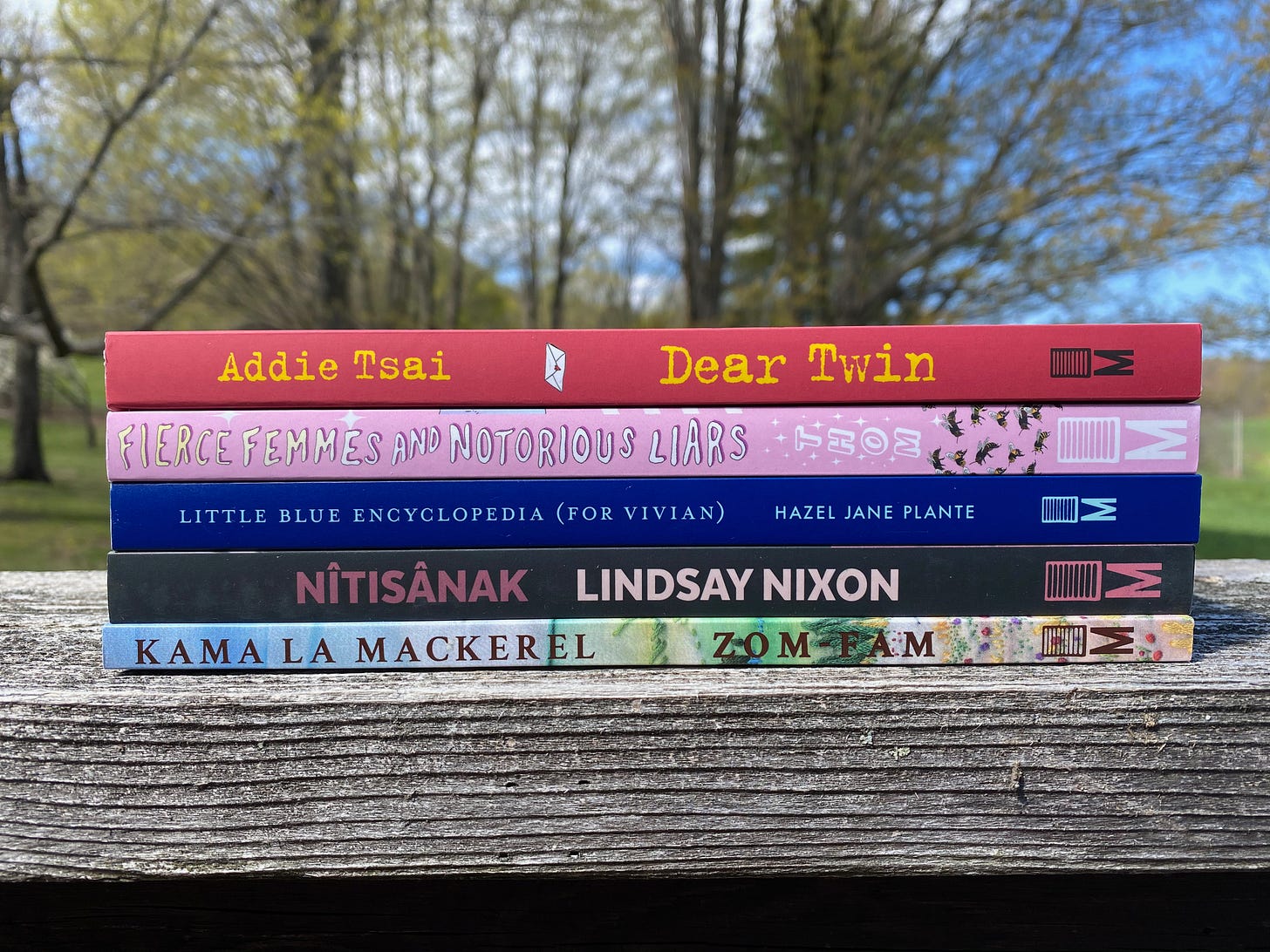
Around the Internet
On Book Riot, I rounded up 20 Must-Read Contemporary Sapphic Novels. You’re so welcome!
Now Out
Hooray! White Magic by Elissa Washuta is now out! Go forth and find yourself a copy.
The Boost
Today’s boost has nothing to do with any of this week’s books. I’m just gushing about an artist whose work I love. I bought this print last week from Eileen Jimenez, a queer Indigenous artist I discovered last year while looking for postcards.
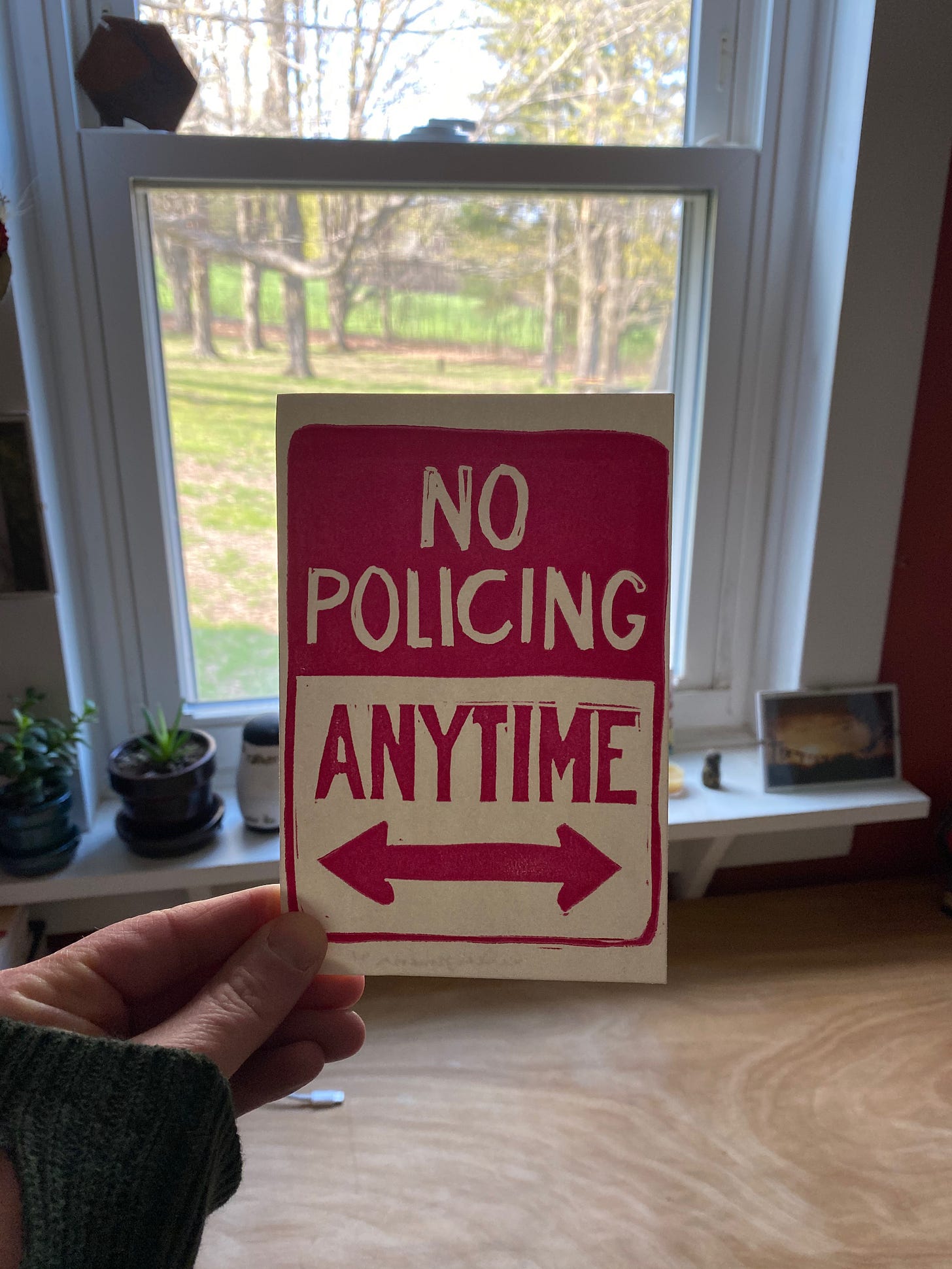
Check out her Etsy store, where you’ll find a ton of beautiful prints, postcards, and stickers. She’s donating the proceeds from the above prints to Families Supporting Families Against Police Violence.
As always, a little bit of beauty to send you on your way: This is the view from my morning walk through the fields behind my apartment. It’s really starting to look like spring around here. Winter will always be my first love, but my heart does beat faster for all that green grass.
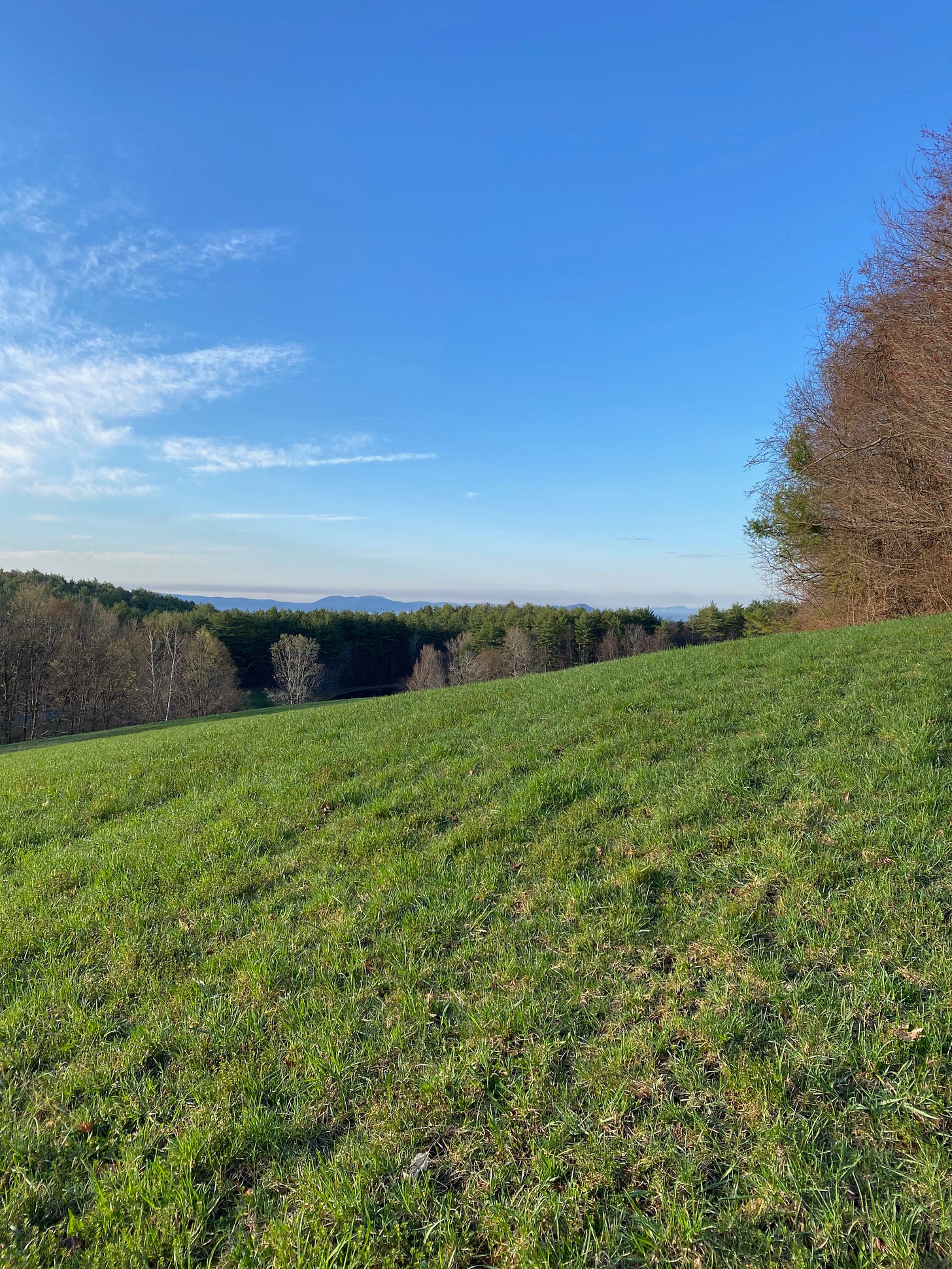
And that’s it until next week. Happy reading, baking, eating, and spring-ing, everyone!

